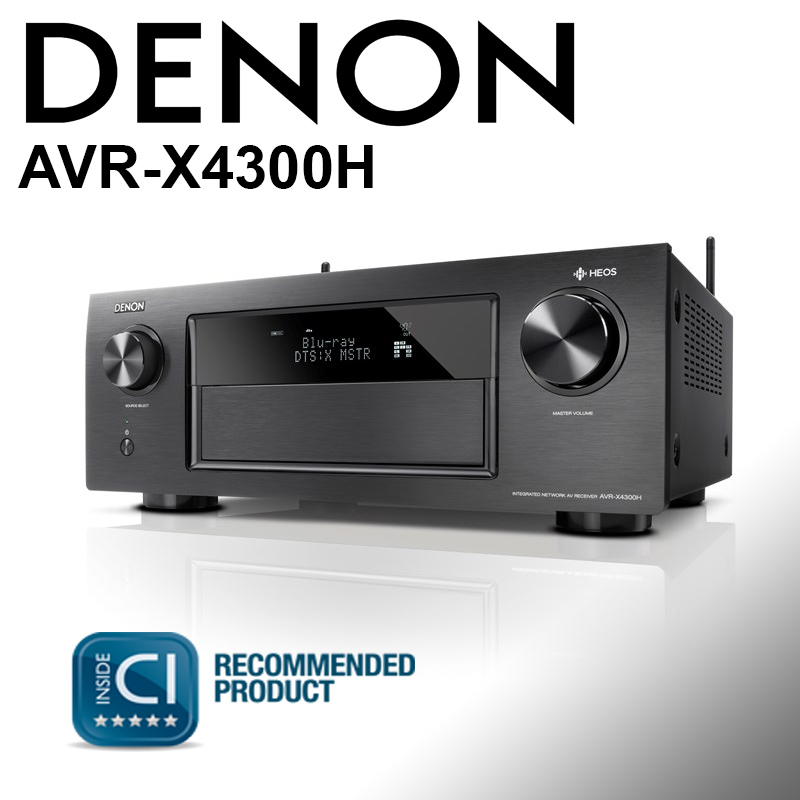DENON AVR-X4300H DOLBY ATMOS HEOS AV RECEIVER REVIEW BY INSIDE CI
Apr 05, 2017

The AV receiver market is evolving. It's no longer good enough simply to offer trouser-flapping volume and codec nirvana (although both help). You also need forward thinking HDMI provision, the widest possible selection of inputs and outputs, and now multiroom too. The Denon AVR-X4300H, an aspirational mid-range model, ticks all those boxes. No matter how complex the system you want to build, this £1299 box should be up to the job.
Denon AVR-X4300H Dolby Atmos HEOS AV receiver: Specification
The AVR-X4300H is a nine-channel design and supports Dolby Atmos and DTS X decoding out of the box; it also offers an upgrade to Auro 3D, for 149 Euros. If your theatre needs to cover all sonic bases, it's clearly a solid choice. The system can also be expanded thanks to the 11.2 pre-amp output.
If you're not installing a 3D audio cinema, you can use spare amplification for a second zone. There are pre-amp outputs for both a second and third zone.
New for Denon this year is the integration of HEOS multiroom support. This means you can integrate the AVR within a larger HEOS ecosystem, where the AVR can be both source and player.
And not only do you get multiroom, but full access to all HEOS supported music services, including Spotify, Tidal, Soundcloud, Napster, Deezer and Tunein Radio. The HEOS implementation even allows you to treat the receiver's multizone output as a separate HEOS 'speaker.' It's exceptionally versatile.
There are seven rear HDMI inputs, plus one on the front fascia, all with HDCP 2.2 support. If you're planning on connecting up every available 4K HDR source, the AVR-X4300H is up to the job. The receiver can upscale all analogue sources to 2160p, useful for non-4K OTT content. 4:4:4 colour sub-sampling is standard.
There are also three HDMI outputs, which again opens up configuration possibilities.
You also get four composite video inputs, twin component inputs, five analogue stereo ins, phono (MM) support plus four digital audio inputs (two optical, two coaxial). There's also the Denon Link HD coaxial link to reduce jitter, for users of the Denon DBT-3313UD Blu-ray player. However, there's no multichannel analogue audio input.
In addition to Ethernet, the receiver supports dual band (2.4 and 5GHz) Wi-Fi, plus Bluetooth. A pair of screw-on aerials are provided. Integrators can call on native Crestron support, plus RS232 and dual 12v triggers.
Denon AVR-X4300H Dolby Atmos HEOS AV receiver: Design and features
Build quality for a mid-range AVR is excellent. The X4300H has a copper plated chassis and mono block construction. It looks the business.
Installation is relatively quick and accomodating. The Denon Setup Assistant offers explanatory speaker layouts and source hook-up diagrams, to speed things along.
Room calibration comes via Audyssey MultEQ XT32. Installers can measure up to eight listening positions, with SubEQ provided to tighten up paired subs in a system. Also included is the familiar cardboard set up microphone stand. More accurate measurements can be afforded by using a proper tripod.
Standard Audyssey features include Dynamic Volume and Dynamic EQ. The former helps alleviate unwanted jumps in volume while the latter retains dynamics at low volume. There's also an LFC (Low Frequency Containment) mode, which uses clever psychoacoustics to contain deep bass. That said, it doesn't help performance, so I would leave it off.
Similarly, amongst the power options is an Intelligent Eco mode. Choose from always On or Auto. The latter only applies Eco settings when the volume is low. Leave it running in 'always on' mode though and you risk unwanted distortion. Once again, I would opt to leave this feature Off.
Integrators might be interested to hear that the receiver supports the Audyssey calibration app, which promises mid-range compensation control, a curve editor and adjustable roll-off control.
Beneath the hood are four fourth-gen SHARC DSP processors, which equate to 10 GLOPS of processing capacity. There's also a new 192kHz/32bit DAC. AL24 Processing Plus provides high-res digital audio filtering for the main stereo channels, said to improve mid-range performance and clarity.
There's also ISF video calibration (Day and Night modes), for pre-screen processing. Denon has also increased the amount of Audio Delay available on this model, up to 500ms.
Denon AVR-X4300H Dolby Atmos HEOS AV receiver: Performance
Popcorn movies should feel right at home with the AVR-X4300H. There's enough muscle available for the average home cinema or media room. Power output is rated at 9 x 200w (into 6 Ohms).
If you're looking to demo Dolby Atmos, the temptation is to run a superhero blockbuster at full pelt. However, why not try somthing different? The Conjuring 2 is a surprisingly effective chiller about London's infamous Enfield haunting. For inventive sound design to dramatic score, this Blu-ray has plenty of jaw-dropping, memorable sound moments. Our AVR-X4300H had a field day with all the creepy goings on.
There are a lot of strings in The Conjuring 2 soundtrack, but the receiver never sounds overwraught. Floorboards creak, spooks groan, spines shiver. As an example of immersive 3D audio mixing it's sensational, and certain to make a lasting impression.
Of course, you don't only need object-based audio for an immersive listening experience. The AVR-X4300H does a fine job upscaling regular content using the DTS Neural: X upmixer. I found this particularly impactful when used on top of video game content.
The receiver is also satisfyingly musical in two channel mode. It finds copious detail in Hi-Res Audio sources, yet never sounds overly analytical. In addition to 24-bit/192kHz WAV and FLAC, and 24-bit/96kHz ALAC/Apple lossless, the receiver plays DSD in both 2.8 and 5.6MHz flavours.
The multiroom HEOS integration is excellent. Using the AVR as a source, you can listen to a connected CD player at any other HEOS speaker location. Multizone streaming is perfect, with no apparent timing errors.
It should be noted that Dolby/DTS bitstreams play out of sync when streamed around multiple HEOS speakers.


